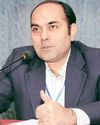A young researcher speaks up for some accused, finds himself hauled up by the cops

A mosi is a tola of Khagariya district in Bihar. It is populated by some 300 musahar families; the musahar is a scheduled caste; at Amosi, they all live in thatched huts. one reaches the village after crossing the river Bagmati twice, so treacherous is its watery course. Amosi tola is some 5 km further up from Etuwa Dhalla, an embankment that contains a brimming Bagmati from inundating the human urban settlements. During the floods, which are an annual recurring phenomenon in the region, Etuwa Dhalla is where the people of submerged villages seek refuge.
Beyond Etuwa Dhalla lies urban chaos – undulated and potholed roads, naked red-brick houses (small and storied), a mass of squeaking people, scurrying poultry and cudding cattle. on the other side of it lie salubrious green fields, scattered thatched settlements and watery streams; people can occasionally be spotted but always in single silhouettes. Both sides exist in their respective worlds and Etuwa Dhalla is their dividing line; it is here that exchange between them is committed, garbs are donned, and a new language of communication is adopted.
Amosi’s claim to fame was its infamy: the village had come under the national spotlight when, in early October 2009, some of its wretched residents were accused of massacring 16 others from a nearby village. The media reported the massacre to be the doing of Naxals and called it an instance of land grabbing by the red insurgents, a possibility later discounted by chief minister Nitish Kumar. The police listed 37 male residents of Amosi tola as accused in the first information report (FIR). The names of the accused apparently were given to the police by the relatives of the victims. out of the 37 accused, a few had been arrested and put in jail; a few others were on the run. They were all Mahadalit, a social category newly christened by the Nitish Kumar government, such a christening being more political than constitutional.
هذه القصة مأخوذة من طبعة July 31, 2017 من GovernanceNow.
ابدأ النسخة التجريبية المجانية من Magzter GOLD لمدة 7 أيام للوصول إلى آلاف القصص المتميزة المنسقة وأكثر من 9,000 مجلة وصحيفة.
بالفعل مشترك ? تسجيل الدخول
هذه القصة مأخوذة من طبعة July 31, 2017 من GovernanceNow.
ابدأ النسخة التجريبية المجانية من Magzter GOLD لمدة 7 أيام للوصول إلى آلاف القصص المتميزة المنسقة وأكثر من 9,000 مجلة وصحيفة.
بالفعل مشترك? تسجيل الدخول

the trump phenomenon
how the 2016 election exposed the us underbelly.

chinnamma is not amma
sasikala may have become the leader of the aiadmk, but she is a far cry from j jayalalithaa, who towered over tamil nadu politics like a colossus.

sakshi malik
sakshi malik is the first indian female wrestler to bag an olympic medal. the 24-year-old comes from mokhra village of rohtak, haryana. she came into the limelight as an international wrestler after she won bronze in the junior world championship in 2010. then, she went on to win silver in the commonwealth games in 2014 and a bronze at the asian wrestling championships in 2015. after rio olympics, malik was conferred india’s highest sporting honour – the rajiv gandhi khel ratna. she is also the brand ambassador of the beti bachao, beti padhao campaign in haryana.

Across The Threshold
A social media campaign aims to bridge gaps between communities by urging people to visit ‘people unlike us’

'How Can An Insurance Firm Promote Death?'
Dr Pankaj Chaturvedi, head and neck cancer surgeon at the Tata Memorial hospital in Mumbai, is a leading antitobacco activist. He joined hands with Sumitra Hooda Pednekar and others to file a PIL in the Bombay high court earlier this year, questioning the staterun insurance firm LIC’s investments in a leading cigarette-maker company. Edited excerpts from an interview with Geetanjali Minhas:

The Wolf And The Lamb
Social injustice and the fate of the university

"Young Dalit Leaders Have Age, Situation On Their Side"
How do you see the rise of the Bhim Army in Uttar Pradesh?During the last assembly elections in UP, it was a common consensus among many [dalit leaders] that we’d give one more chance to Mayawati.

Timely Delivery
A veteran bureaucrat explains how to complete government projects without time and cost overruns.

Cauvery Water Dispute
India’s leading water expert and president of the South Asia Consortium for Inter disciplinary Water Resources Studies, S Janakarajan, wonders why Chennai, a city that receives 1,250 mm rainfall, is called a thirsty city and goes on to explain to Shivani Chaturvedi what went wrong among the southern states that led to a water-war like situation. But, he warns that such a scenario will keep occurring if the government does not come up with a lasting solution.

Case Against Cash
Can you imagine a day without cash?